|
Answers - Electric Fields
|
|
|
1.
|

- The magnitude of the force of +Q or -Q on qo
at r = 3 m is FqQ = kQqo/r2
= (9.0 x 109 N-m2/C2)(2
x 10-6 C)(10-12 C)/(9 m2)
= 2 x 10-9 N.
The force of +Q on +q0 at
- P1 is to the right since +Q repels +qo
and urges it to the right
- P2 is to the left since +Q repels +qo
and urges it to the left.
- The force of -Q on + qo at
- P1 is to the left since -Q attracts +qo
and urges it to the left
- P2 to the right since -Q attracts +qo
and urges it to the right.
|
|
|
2.
|
By definition, the direction of the electric
field is the direction in which a positive test charge is urged.
The magnitude of the electric field at a point P is equal to
the electric force Fe on a test charge qo
divided by the test charge.
For all points in Fig. 1 above, the magnitude of the electric
field = (Fe)/qo = (kQqo/r2)/qo
=
kQ/r2 = (9 x 109 N-m2/C2)(2
x 10-6 C)/9 m2 = 2 x 103 N/C.
- In Fig. 1a, the electric field at P1 is to
the right because a positive test charge there would be
urged to the right. At P2 the electric
field is to the left because a positive test charge there
would be urged to the left.
- In Fig. 1b, the electric field at P1 is to
the left because a positive test charge there would be urged
to the left. At P2 the electric field is
to the right because a positive test charge there would
be urged to the right. Do not use the sign of a charge setting
up a field to determine the direction of a field. Go to
the point, imagine placing a positive test charge there,
and ask what direction the test charge would be urged by
the charge setting up the field.
|
|
|
3.
|

- In general the electric field E due to a point charge
Q a distance r from the point where you wish to find the
field is given by
E = (9 x 109 N-m2/C2)Q/r2.
For q1 in Fig. 2, E1 = (9 x 109
Nm2/C2)(9 x 10-9 C)/(3
m)2 = 9 N/C to the right because if a positive
test charge is placed at P, q1 would urge it
to the right. E2 = (9 x 109 N-m2/C2)(1
x 10-9 C)/ (1 m)2 = 9 N/C to the right
because if a positive test charge is placed at P, q2
would urge it to the right. The resultant field at P is
E = (9 + 9) N/C = 18 N/C to the right. Again notice
the importance of not using the negative sign of the charge
in finding the field. If you had used the negative sign,
you might have said the field due to q2 was to
the left.
- If q2 = +1 nC, the electric field
due to q2 at P is 9 N/C to the left. Now taking
to the right as positive, the resultant field at P is E
= (9 - 9) N/C = 0.
|
|
|
4.
|
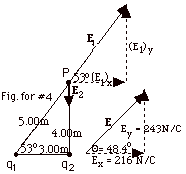
In Fig. for #4 above, the hypotenuse of the triangle = (9.00
+ 16.00)1/2 m = 5.00 m.
The field due to q1, E1 =
q1/4πεor12
= 9 x 109 N-m2/C2(10-6
C/25.0m2)
= 360 N/C. The direction of E1 is
shown in Fig. for #4.
E2 = 9 x 109 N-m2/C2(0.0800
x 10-6 C/16.00 m2) = 45 N/C, and
E2 = -45 j N/C, as
shown in Fig. for #4.
Taking components of E1, (E1)
x = E1 cos 53o = 360 N/C (0.60)
= 216 N/C,
and (E1)y = E1 sin 53o=
360 N/C (0.80) = 288 N/C. The component of the resultant
E in the y direction Ey = (E1)y
+ (E2)y = (288 - 45) N/C = 243 N/C.
E = (216 i + 243 j)N/C. E
= {(216)2 + (243)2}1/2 =
325 N/C.
tan Θ = 243/216.
Θ = 48.4o with
X-axis.
|
|
|
5.
|
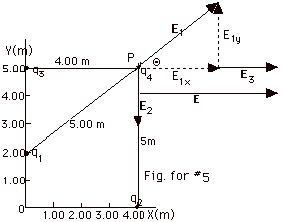
- In the Fig. for #5 above, E1 represents
the electric field due to
q1 = 5.00 x 10-6 C, which is
r = 5.00 m from P.
E1 = kq1/r2 = 9 x 109
N-m2/C2 (5.00 x 10-6C)
25.0 m2
= 1.80 x 103 N/C.
E1x = E1 cos Θ=
1.80 x 103 N/C (0.800) = 1.44 x 103 N/C.
E1y = E1 sin Θ=1.80
x 103 N/C (0.600) =1.08 x 103 N/C.
In the Fig. for #5 above, E2 represents
the electric field due to
q2 = -3.00 x 10-6 C, which is a distance
of r2 = 5.00 m from P.
E2 = kq2/r2 = 9 x 109
N-m2/C2 (3.00 x 10-6)/25.0
m2 = 1.08 x 103 N/C
in the negative Y direction (Fig. for #5).
E2x = 0 and E2y = -1.08 x 103
N/C.
In the Fig. for #5, E3 represents
the electric field due to
q3 = 1.60 x 10-6 C, which is a distance
of r3 = 4.00 m from P.
E3 = kq3/r3 = 9 x 109
N-m2/C2 (1.60 x 10-6)/16.0
m2 = 0.900 x 103 N/C
in the positive X direction as shown in Fig. for #5.
E3x = 0.900 x 103 N/C and
E3y = 0.
Let the total electric field = E.
Ex = E1x + E2x + E3x
= (1.44 + 0 + 0.90)103 N/C = 2.34 x 103
N/C.
Ey = E1y + E2y + E3y
= (1.08 -1.08 + 0)103 N/C = 0. The resultant
electric field is totally in the +X direction and it is
equal to 2.34 x 103 N/C.
- The force on q4 at P = q4E = (2.0
x 10-6 C)(2.34 x 103 N/C) =
4.68 x 10-3 N to the right.
|
|
|
6.
|
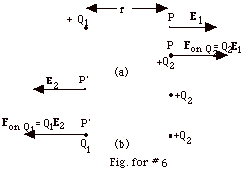
In Fig. for #6a above, we think of Q1 setting up
a field E1 at P, where E1 = kQ1/r2
to the right. When Q2 is placed at P, it experiences
a force Fon Q2, where Fon Q2 =
Q2E1 = kQ1Q2/r2
to the right. In Fig. for #6b, we think of Q2 setting
up a field E2 at P’, where E2
= kQ2/r2 to the left. When Q1
is placed at P’, it experiences a force Fon
Q1, where Fon Q1 = Q1E2
= kQ1Q2/r2 to the left. This
is the same result of the force on Q2 due to Q1
and the force on Q1 due to Q2
found from Coulomb's law.
|
|
|
7.
|
The electric field due to the positive
point charge depends inversely upon the square of the distance
from the positive point charge. A negative charge placed in
the electric field of the positive point charge will experience
a force that depends on the electric field. Since the field
varies with the distance from the positive charge, the force
F on the negative charge depends on the distance. The acceleration
experienced by the negative charge will not be constant.
a = F/m.
|
|
|
8.
|

First we decide that the point where the electric field is
zero cannot be between the two charges because at any point
between them the electric field due to either charge is to
the right so that the electric fields would add rather than
cancel. The field also cannot be to the right of charge q2
at some point P'. Although the field due
to q2 at P' is to the left and the field due to
q1 to the right, the field due to q1 cannot
cancel the field due to q2 because q2
is closer to P' than q1 and charge q2
is greater than q1. For point P, the field due
to q1 is kq1/x2 to the left
and the field due to q2 is kq2/(x +
0.10 m)2 to the right. The field at P is zero if
kq1/x2 = kq2/(x
+ 0.10 m)2 or
1.0 x 10-6 C/x2 = 4 x 10-6 C/(x
+ 0.10m)2 or
(x + 0.10 m)2 = (4.0/1.0)x2.
(Equation
1)
Taking the square root of both sides of Eq. 1,
x + 0.10 m = 2.0 x and
x = 0.10 m.
|
|
|
9.
|
- The number of field lines is proportional to the electric
flux which is proportional to the charge enclosed by the
Gaussian surface. If the field lines leave the point charge,
the net enclosed charge is positive. If the field lines
enter the Gaussian surface the net charge enclosed is negative.
The ratio of the the field lines give the ratio of the charge.
q1/q2 = 10 μC/q2
= 15/75 or
q2 = 50 μC.
Since the field lines enter the Gaussian surface,
q2 = -50 μC.
- If the field lines point out of the Gaussian surface
it means that the net charge is positive. In other words,
the surface could enclose some negative charge, but there
are more positive charge than negative so that the net charge
enclosed is positive.
|
|
|
10.
|

The electric field due to an infinite sheet of charge is σ/2 εo.
The direction of an electric field at a point P is that in which
a positive test charge placed at that point would be urged.
As shown in Fig. for #10 above,
- at point P1 the electric field due to the sheet
on the left Ea is to the left, the electric
field due to the center sheet Eb is to
the right and the electric field due to the sheet on the
right Ec is to the left. Taking to the
right to be positive, the electric field is to the left
with magnitude E (at P1) =
-σ/2 εo
+ σ/2 εo
- σ/2 εo
= - σ/2 εo.
- At point P2 the electric field due to the sheet
on the left Ea is to the right, the electric
field due to the center sheet Eb is to
the right and field due to the sheet on the right Ec
is to the left. Taking to the right to be positive,
the E is to the right with magnitude E (at P2)
=
+σ/2 εo
+ σ/2 εo
- σ/2 εo
= + σ/2 εo.
- At point P3 the electric field due to the sheet
on the left Ea is to the right, the electric
field due to the center sheet Eb is to
the left and the electric field due to the sheet on the
right Ec is to the left. Taking to the
right to be positive, the electric field is to the left
with magnitude E (at P3) =
σ/2 εo
- σ/2 εo
- σ/2 εo
= - σ/2 εo
.
- At point P4 the electric field due to the sheet
on the left Ea is to the right, the electric
field due to the center sheet Eb is to
the left and the electric field due to the sheet on the
right Ec is to the right. The electric
field is to the right with magnitude E (at P4)
=
σ/2 εo
- σ/2 εo
+ σ/2 εo
= σ/2 εo.
|
|
|
11.
|
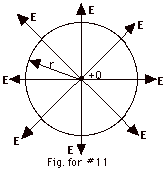
In Fig. for #11 above, a hypothetical sphere of radius r and
surface area 4 πr2
is drawn around +Q. The electric field E is perpendicular
to this hypothetical sphere. Thus, number of electric field
lines/area = E or number of electric field lines = E(area)
= (kQ/r2)(4 πr2)
= (k)Q(4 π) = (1/4πεo)Q(4 π)
= Q/ εo.
|
|
|
12.
|

In the Fig. for #12 above, the spherical Gaussian surface for
r < R and r > R are drawn with dashed lines. By symmetry,
the electric field at both surfaces is perpendicular to the
surfaces. If you rotate the sphere of charge, you should not
expect the electric field direction on the Gaussian surface
to change. This will only be true if the field is radially outward.
E is normal to the surface, that is, the angle between
E and dA is zero and E . dA
= E dA cos 0o = E dA. If you rotate the
charged sphere the magnitude of E on the Gaussian surface can
not change. E is constant everywhere on the surface.
 = E 4 πr2
= E 4 πr2
- For r < R, the Gaussian surface does not enclose the
total charge Q.
Charge/volume = Q/V = ρ=
Q/(4 πR3/3),
where 4 πR3/3
= V = the volume of the charged sphere. The charge enclosed
by a Gaussian surface with r < R
= ρ (Volume
of the Gaussian surface)
= {Q/(4/3 πR3}(4/3
πr3) =
Qr3/R3
For r < R, E (Area of Gaussian
Surface) = charge enclosed/ εo,
which becomes
E4 πr2
= Qr3/R3 εo
or
E = Qr/4πεoR3
= kQr/R3 (Equation
1)
- For r > R, the Gaussian surface encloses all the charge
Q, E4 πr2
= Q/ εo. or E
= Q/4πεor2
= kQ/r2 (Equation
2)
If you let r = R in Eq. 1 or in Eq. 2, you get E = kQ/R2.
Both expressions are equivalent at r = R, so we may write
for r ≤ R, E = kQr/R3 = (kQ/R3)r,
that is, E = constant times r, so E is directly proportional
to r, and a plot of E vs. r for r ≤ R yields a straight
line. For r ≥ R, E = kQ/r2 for a
sphere of radius R with a uniform distribution of charge.
Notice for r ≥ R, the sphere “acts” like
a point charge Q located at the center of the sphere. A
plot of E as a function of r is shown in the above figure.
|
|
|
13.
|

- In the figure above, the Gaussian surfaces for r
< a, a < r < b,
b < r < c, and r > c are
shown by dashed surfaces. Using the same arguments we did
in Problem 12, we establish that the electric field is perpendicular
to the Gaussian surfaces and constant everywhere on them.
The definition of a conductor is that electrons are perfectly
free to move in them. They move until there is no electric
field inside the conductor, which would produce a motion
of charges. Since there is no electric field inside the
sphere of radius a, there can be, in agreement with Gauss'
theorem, no charges enclosed by a surface inside the sphere.
You can use this argument until r goes to a and decide the
+Q is on the outside of the sphere of radius a. In addition,
since there can be no electrical field inside the spherical
shell, the Gaussian surface for b < r <c must
enclose no net charge. The - Q must be on the inner
surface of the spherical shell of radius b and the +Q must
be on the outside of the shell of radius c. This gives the
net charge on the shell equal to +Q - Q = 0. From all of
this we conclude by Gauss' theorem, (E)(Area of Gaussian
surface) = charge enclosed/ εo.
- For r < a,
E(4 πr2)
= 0
E = 0
- For a < r < b,
E(4 πr2)
= Q/ εo
E = Q/4πεor2
= kQ/r2
- For b < r < c,
charge enclosed = + Q - Q = 0 so
E(Area) = 0 or
E = 0
- For r > c
E(4 πr2)
= (Q - Q + Q)/ εo
= Q/ εo
E = Q/4πεor2
= kQ/r2
|
|
|
14.
|

A Gaussian surface surrounding the point charge q1
encloses an electric flux Φ from
r = 0 to r = a equal to
(charge enclosed)/ εo
=
8.85 x 10-6 C/8.85 x 10-12 C2/N-m2
= 106 N-m2/C.
- The electric flux Φ from
r = a to b must be zero because this region
is inside a conductor. For the flux to be zero, a Gaussian
surface there can enclose no charge. Thus qa
= - q1 = -8.85 x 10-6 C.
- Since the net charge on the inner shell is -17.70 x 10-6
C = qa + qb,
qb = -17.70 x 10-6 C
- qa
= -17.70 x 10-6
C - (-8.85 x 10-6 C)
= -8.85 x 10-6
C.
The electric flux from b to c = charge enclosed/ ε0
= (q1 + qa + qb)/ εo
=(8.85 - 8.85 - 8.85)10-6C/8.85 x 10-12
C2/N-m2 = -106 N-m2/C.
The electric flux inside the outer shell from c to d = 0
= charge enclosed/ ε0
= (q1 +qa + qb +
qc)/ εo
or (8.85 -8.85 -8.85)10-6 C = -qc
and qc = 8.85 x 10-6 C.
Since the net charge on the outer shell is +17.70 x 10-6
C, = qc + qd = 8.85 x 10-6 C
+ qd, qd = 8.85 x 10-6
C.
From d to infinity, the electric flux equals (charge enclosed)/ εo
=(q1 +qa + qb
+ qc + qd)/ εo
=(8.85 - 8.85 - 8.85 + 8.85 + 8.85)10-6 C/8.85
x 10-12 C2/N-m2
= 106 N-m2/C.
- From 0 to a, Φ= 106
N-m2/C.
From a to b, Φ= 0.
From b to c, Φ =
-106 N-m2/C.
From c to d, Φ= 0.
From d to infinity, Φ
= 106 N-m2/C.

|
|
|
15.
|

- The charge density = total charge/volume ρ =
Q/(4 πR3/3).
Each sphere has the same total charge Q. The sphere in Fig.
8d above has the largest radius. The charge density ρ is
inversely proportional to the cube of the radius. The ranking
of charge densities with the greatest first is Fig. 8a >
Fig. 8b > Fig. 8c > Fig. 8d.
- For a point P outside of the charge distribution, as in
Fig. 8a and Fig. 8b, all the charge acts at the center and
the electric field for both is E = kQ/r2 where
r is the distance from the center of the sphere to point
P. The electric field at P for Fig. 8a and Fig. 8b are equal.
For Fig. 8c and 8d, a Gaussian spherical surface drawn with
a radius r from the center of the sphere to P would not
enclose the total charge so the fields would be smaller
than those for Fig. 8a and Fig. 8b. Since such a Gaussian
surface would enclose more charge for Fig. 8c than for Fig.
8d, the electric field would be greater for Fig. 8c than
for Fig. 8d. As we found in Problem 12, for r <
R, E = kQr/R2. The rankings for highest
field are Fig. 8a and Fig. 8b tie for first, Fig. 8c is
third, and Fig. 8d comes in last.
|
|
|
16.
|
The tangent to an electric field line
at any point gives the direction of the electric field at
that point. If two electric field lines intersected, the tangent
to the field lines at that point and the electric field at
that point would have different directions and that is not
possible.
|
|
|
17.
|

- Fe = qE = (3.2 x 10-19 C)(20 x 102
N/C) = 6.4 x10-16 N. Since the electric
field is down and the charge is positive, the electric force
is down.
- The acceleration due to this force a = Fe/m
= 6.4 x 10-16 N/1.6 x 10-27 kg = 4.0
x 1011 m/s2 down.
- The acceleration due to the gravitational force = g =
9.8 m/s2 down.
- Since the acceleration due to the gravitational force
is much smaller than the acceleration due to the electric
force we can ignore it and say ay = 4.0 x 1011
m/s2. There is no acceleration in the X-direction,
that is, ax = 0.
x(t) = xo + voxt + 1/2 axt2.
Since ax = 0, vox = v = 4.0
x 106 m/s,
and taking xo = 0 with the X-Y axes as shown
in Fig. 6 above,
x = voxt or t = x/vox
= 0.80 m/4.0 x 106 m/s = 2.0 x 10-7
s.
- y(t) = yo + voyt + 1/2 ayt2
= y(2.0 x 10-7 s) =
0 + 0 + 1/2(4.0 x 1011m/s2)(2.0 x
10 - 7 s)2 = 8.0 x 10-3
m.
|
|
|
18.
|
- The force (Fe)p on the proton is
in the direction of the electric field and equal to qE.
The acceleration ap of the proton is in
the same direction as the force and equal to (Fe)p/m
= eE/m, where m is the mass of the proton.
- The velocity vp and the displacement xp
of the proton are in the same direction as the acceleration.
vp(t) = vo + apt
= 0 + (eE/m)t.
xp(t) = xo + vot + 1/2
apt2 = 0 + 0 +1/2(eE/m)t2.
|
|
|
19.
|
The force (Fe)α
on the alpha particle is in the direction of the electric
field and equal to 2eE. The acceleration aα
of the alpha particle is in the same direction as the force
and equal to (Fα)/4m
= 2eE/4m, where m is the mass of the proton. The velocity
vα and the
displacement xα
are in the same direction as the acceleration.
Vα(t) = vo
+ aαt
= 0 + (2eE/4m)t = vp/2.
xa(t) = xo + vot + 1/2 aαt2
= 0 + 0 +1/2(2eE/4m)t2 = xp/2.
|
|
|
20.
|
The force on a charged particle q in
an electric E is Fe = qE. The electric force
is independent of the speed of the particle. Whether the particle
is initially at rest or moving with a velocity v, the force
on it is qE.
|
|
|
21.
|
The electric field E due to a very long, uniformly charge wire
is λ/2πεor
radially outward for a positive charge per unit length
λ. An electron moving
around the wire experiences a force in toward the axis of the
wire = eE = e λ/2 πr εo.
This force in toward the center produces a centripetal
acceleration.
Fnet = ma
e λ/2 πr εo
= mv2/r
(e λ/2 πm εo)
= v2
1.6 x 10-19 C(2.5 x 10-9 C/m)/2 π(9.1
x 10-31 kg)(8.85 x 10-12 C2/N-m2)
= v2
v = 2.8 x 106 m/s.
|
|
|
22.
|

The electric force on the sphere of charge q is Fe
= qE. The electric field due to the sheet E = σ/2 εo.
For the sphere to remain at rest, the net force
on it must equal zero, that is T + mg
+ qE = 0, where T is the tension in the
string. From the geometry of the figure, we see that
tan Θ = qE/mg = (qσ/2 εo)/mg
or
σ = 2 εomg
tan Θ/q.
|
|
|
23.
|
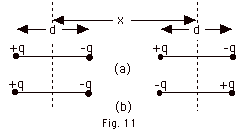
Taking to the right to be positive for the force of the charges
in the dipole at the left on the charges in the dipole at the
right in Fig. 11a above,
F = kq2/x2 - kq2/(x +d)2
- kq2/(x - d)2 + kq2/x2
Putting the above expression over the common denominator
x2(x2 + d2) (x2
- d2) gives:
F = {kq2/[ x2(x + d)2 (x
- d)2]}{2(x + d)2 (x - d)2
- x2(x - d)2 - x2(x +d)2}
= {kq2/[ x2(x2
- d2)2} {2(x2 – d2)2
- x2(x - d)2 - x2(x +d)2}
= {kq2/[ x2(x2
- d2)2} {2(x4 – 2x2d2
+ d4) - x2(x2 - 2dx + d2)
- x2(x2
- 2dx + d2)}
= {kq2/[ x2(x2
- d2)2} {-6x2d2 +
2d4}
Since 6x2d2 > 2d4, the
net force on the dipole to the right will be to the left.
By Newton's third law, the net force on the dipole to the
left will be equal in magnitude, but to the right.
For Fig. 11b, again taking to the right to be positive for
the forces of the charges in the dipole at the left on the
charges of the dipole at the right,
F = = -kq2/x2 + kq2/(x +d)2
+ kq2/(x -d)2 - kq2/x2.
The magnitude of the force is the same as in (a), but opposite
in direction. Notice for x >> d, |F| = |{kq2/[
x2(x2 - d2)2}
{-6x2d2 + 2d4}| reduces
to 6kq2d2/x4 = 6kp2/x4,
where p = the dipole moment.
|
|
|
24.
|
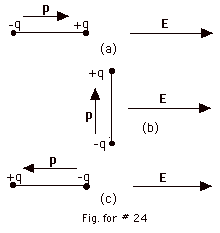
In general the torque τ= p x E
τ = pE sin  p,
E p,
E
- For p parallel to E (Fig. for 24a above)
 p,
E = 0, sin 0o = 0, so τ= 0. p,
E = 0, sin 0o = 0, so τ= 0.
- For p perpendicular to E (Fig. for 24b
above)
 p,
E = 90o, sin 90o = 1,
so τ= pE =[qd](E) p,
E = 90o, sin 90o = 1,
so τ= pE =[qd](E)
=
[(3.2 x 10-19 C)(2 x 10-9 m)](5.0
x 105 N/C)
=
3.2 x 10-22 N-m.
The direction of the torque is into the page.
- For p antiparallel to E (Fig. for 24c
above)
 p,
E = 180o, sin 180o = 0,
so τ= 0. p,
E = 180o, sin 180o = 0,
so τ= 0.
|
|
|
25.
|
- You can find an electric field due to a distribution of
charges by
- finding the electric field due to each point individually
and then adding them vectorally or
- using Gauss's theorem if the charge distribution
has spherical, cylindrical, or plane symmetry.
- Once you know an electric field E, you can find the electric
force Fe on a charge q from Fe = qE.
|
|
|